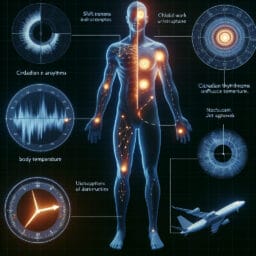10 Foods to Avoid That Can Disrupt Your Circadian Rhythms
Table of Contents
- Introduction
- Caffeine-Rich Foods and Beverages
- High-Sugar Foods
- Heavy or Greasy Foods
- Spicy Foods
- Alcoholic Beverages
- Processed Meats
- Refined Carbohydrates
- Artificial Sweeteners
- Acidic Foods
- Conclusion
- Frequently Asked Questions
Introduction
Navigating the complex world of circadian rhythms reveals a fascinating interplay between our dietary choices and the internal clocks that govern our bodies. This intricate system, comprising a master clock in the brain and peripheral clocks in various organs, orchestrates physiological processes to align with the 24-hour cycle of day and night. However, when this harmony is disrupted—often due to consuming certain edibles—it can lead to a cascade of metabolic disruption. For instance, shift workers who adapt their meal timing to unconventional hours face an increased risk of insulin resistance and type diabetes—a systematic review from the National Center for Biotechnology Information underscores this link.
Diet composition plays a pivotal role in maintaining circadian regulation. Mice fed high-fat diets during their inactive phase—an equivalent scenario to humans eating late at night—display altered energy expenditure patterns and disruptions in their liver clock genes. Similarly, nocturnal rodents experiencing irregular light exposure suffer from adverse effects on their adipose tissue function, mirroring the challenges faced by individuals subjected to dim light during night shifts or those using exogenous melatonin supplements inconsistently.
It’s not just what we eat but when we eat that matters; intermittent fasting has shown promise as a method for reinforcing circadian rhythms through defined feeding behavior coupled with extended fasting periods which may counteract circadian misalignment. On another front, caloric restriction without malnutrition has been associated with benefits extending beyond weight loss: research suggests it can fine-tune peripheral clocks across different tissues.
As scientific curiosity converges with medicine biotech information advances, understanding how factors like diet composition affect our biological rhythms becomes crucial. By judiciously considering meal timing and content—preferably under low-intensity lighting—we might aid our circadian system’s alignment with external environment cues, promoting overall health resilience against modern lifestyle pitfalls such as sleep deprivation and erratic eating habits typical of active phases gone awry.
Caffeine-Rich Foods and Beverages
Diet composition is a cornerstone in maintaining harmonious circadian rhythms, and caffeine stands out as a potent disruptor of our biological clocks. Consuming coffee, energy drinks, or even chocolate can send ripples through the delicate fabric of our circadian system, often leading to an out-of-sync master clock. This misalignment not only affects sleep patterns but can also leave one’s alertness swinging like a pendulum between heightened wakefulness and untimely fatigue. It’s important to recognize that while caffeine might promise immediate vigor, it covertly undermines the peripheral clocks in various organs, contributing to metabolic disruption.
For shift workers or those under the spell of sleep deprivation due to night shifts, caffeinated beverages may seem like a lifeline. Yet this salvation is short-lived; the National Center for Biotechnology Information advances science by highlighting how these stimulants increase the risk of insulin resistance—closely intertwined with disrupted circadian rhythms. The systematic review posits that erratic consumption during one’s inactive phase could exacerbate circadian misalignment.
To combat these effects and promote circadian regulation, intermittent fasting emerges as an intriguing strategy—encouraging defined feeding behavior coupled with fasting periods that restore rhythm to our core clock genes. By managing caffeine intake strategically within active phases and avoiding consumption close to bedtime, we leverage medicine biotech information to align our dietary habits with natural light exposure—a vital cue for our internal environment—and bolster overall health against adversities such as type diabetes wrought by misaligned eating patterns.
High-Sugar Foods
Unbeknownst to many, the sweet temptation of high-sugar foods goes beyond mere calorie concerns—it directly impacts our circadian system’s balance. From candy bars to sugary cereals and decadent pastries, these treats can significantly disrupt sleep-wake cycles and interfere with the delicate workings of peripheral clocks throughout the body. The consumption of such foods, particularly during the inactive phase typically reserved for rest, has been linked to metabolic disruption and an increased risk of insulin resistance—conditions that are intricately entwined with circadian misalignment.
The master clock within our brains is designed to synchronize our internal environment with the external world’s natural light-dark cycle; however, indulging in sugar-laden snacks can alter this harmony. Shift workers often fall victim to disrupted circadian rhythms due to erratic meal timing combined with exposure to dim light during night shifts—a double whammy for their biological clocks. As science from institutions like the National Center for Biotechnology Information advances, we gain a clearer understanding of how diet composition affects energy expenditure and overall health.
To foster optimal circadian regulation, consider embracing intermittent fasting strategies which align feeding behavior with your active phase while avoiding caloric intake during times typically reserved for slumber. This fasting period helps recalibrate core clock genes across peripheral tissues. Additionally, reducing sugar intake not only aids in weight loss endeavors but also supports your circadian clocks’ alignment by minimizing hormonal fluctuations that can lead to sleep disruptions. By mindfully curating your diet and tuning into cues from medicine biotech information providing access on how foods affect our internal rhythms, you hold a key piece in achieving balanced health against modern lifestyle challenges—including those posed by nocturnal rodents’ counterpart: night shift work.
Heavy or Greasy Foods
Our circadian rhythms—those intrinsic timekeepers—are highly sensitive to dietary intrusions, and none are more intrusive than heavy or greasy foods. Fast food, fried delights, and other high-fat indulgences do more than strain the waistline; they wreak havoc on our internal timing systems. Shift workers who often reach for these quick fixes face a double jeopardy; not only are they battling the disorienting effects of dim light during night shifts, but their meal choices further exacerbate circadian misalignment. The liver clock, a critical peripheral clock involved in metabolic regulation, is particularly vulnerable to such diet composition.
These calorie-dense meals can alter energy expenditure across different phases of activity and rest. Consuming them during the inactive phase—a time when our bodies should be winding down—can impede sleep quality and contribute to insulin resistance. As both anecdotal evidence from those working night shifts and systematic reviews from authorities like the National Center for Biotechnology Information suggest, there’s an increased risk linked with disrupted feeding behavior that ignores the nuances of circadian regulation.
To align with our natural circadian clocks while still satisfying hunger pangs, consider alternatives that support our core clock genes without contributing to metabolic disruption: grilled proteins rich in omega-3 fatty acids instead of fried meats; complex carbohydrates over refined ones providing access to sustained energy rather than a rapid spike in blood sugar levels. Embracing intermittent fasting can also reinforce feeding behavior attuned to the active phase while curtailing calories during sleep time. This fasting period helps synchronize peripheral tissues with environmental light exposure—a remedy echoing through medicine biotech information as a beacon of health against modern-day challenges like sleep deprivation tied to irregular shift work.
Spicy Foods
Spicy foods, infused with the heat of capsaicin from hot peppers and tantalizing sauces, can be a double-edged sword for our circadian system. While they add zest to our meals, their consumption close to bedtime may ignite sleep disturbances and disrupt the delicate balance of our circadian rhythms. The capsaicin in these fiery delights has been shown to elevate body temperature—a signal that can confuse the master clock’s interpretation of night and day. For individuals practicing circadian rhythm fasting, it becomes crucial to schedule spicy meals well within their active phase when metabolism is primed for higher energy expenditure, thus avoiding interference with the fasting period that facilitates resetting peripheral clocks.
Shift workers already grappling with dim light during night shifts are particularly susceptible to such dietary pitfalls; when meal timing coincides with their inactive phase, the risk for metabolic disruption and insulin resistance climbs—a circadian misalignment all too common among those facing nocturnal schedules. To promote circadian regulation even amidst challenging work patterns, strategic meal planning that accounts for diet composition becomes essential. By optimizing light exposure during waking hours and aligning intake of spicier fare earlier in the day, we support liver clock synchrony and enhance overall health—insights echoed by medicine biotech information as critical elements in combatting sleep deprivation tied to erratic lifestyles.
For those seeking weight loss or improved metabolic health through caloric restriction or intermittent fasting, understanding how diet influences our internal environment is vital. As research advances science within biotechnology information hubs like the National Center provide access to knowledge on how foods affect adipose tissue function and core clock gene expression—valuable tools in fine-tuning feeding behavior toward better alignment with natural circadian cycles.
Processed Meats
Delving into the intricacies of circadian regulation, it becomes increasingly clear that processed meats like bacon, sausages, and deli slices are more than just dietary indulgences; they are potential saboteurs of our internal timing systems. These foods, often high in sodium and preservatives, can significantly influence peripheral clocks—particularly the liver clock which plays a pivotal role in metabolic processes. As nocturnal rodents have demonstrated in studies observing their reactions to altered feeding schedules, shifts in diet composition precipitate marked changes in energy expenditure patterns and circadian rhythm synchronization. For shift workers who rely on convenience foods during night shifts under dim light conditions, these seemingly innocuous snacks could pose an increased risk for metabolic disruption and insulin resistance.
The relationship between meat-heavy diets and disrupted circadian rhythms is not trivial; it underscores a broader narrative where meal timing intersects with the risks associated with type diabetes—a condition closely linked with circadian misalignment. Understanding this connection provides critical insights for those aiming for weight loss or managing health through caloric restriction. By aligning consumption of processed meats within the active phase of one’s daily cycle and respecting the fasting period essential for resetting core clock genes, individuals can better maintain harmony within their circadian system. This strategic approach to feeding behavior encourages a symbiosis between diet composition and light exposure—the latter being a fundamental cue for our master clock that governs sleep-wake cycles as well as other physiological functions.
In harnessing these findings from biotechnology information advances science sheds light on how we might mitigate adverse effects on adipose tissue function through informed dietary choices—critical consideration for anyone grappling with sleep deprivation or irregular eating habits due to night shift work. With medicine biotech information providing access to systematic reviews on such topics as intermittent fasting’s benefits on peripheral tissues’ clocks, there is now a blueprint available to navigate the complex relationship between what we eat—and when—and our overall health.
Refined Carbohydrates
Refined carbohydrates, prevalent in white bread, pasta, and crackers, may seem like a quick energy fix but can severely impact the delicate balance of our circadian clocks. These foods lead to rapid spikes in blood sugar levels which not only thwart weight loss efforts but also contribute to metabolic disruption that echoes through the entire circadian system. The consumption of such simple carbs particularly during the inactive phase disrupts the liver clock’s natural cycle, increasing the risk for insulin resistance—a prevalent issue among shift workers who grapple with misaligned meal timing under dim light conditions during night shifts.
A diet rich in complex carbohydrates offers a more stable release of glucose into the bloodstream, supporting consistent energy expenditure and aligning with our body’s natural active phase. This stability is conducive to maintaining core clock gene regularity which aids in regulating sleep-wake cycles and peripheral tissues’ functions. For those engaged in circadian rhythm fasting or caloric restriction aimed at weight loss, incorporating whole grains and fibrous vegetables sustains satiety over extended periods—key for enduring intermittent fasting without succumbing to hunger pangs during critical fasting periods.
By replacing refined carbs with their complex counterparts within your diet composition and carefully planning meal timing per biotechnology information advances science from sources like the National Center for Biotechnology Information (NCBI), individuals can support their master clock against disruptions while fostering a robust external environment-circadian regulation axis—a vital step toward mitigating risks associated with night shift work and sleep deprivation. With mindful eating habits centered around robust circadian clocks and optimal light exposure patterns, one can harness synergies between diet choices and biological rhythms that bolster overall health.
Artificial Sweeteners
Artificial sweeteners, including aspartame and sucralose, are often considered a calorie-free boon to weight loss efforts, yet their impact on circadian rhythms paints a more complicated picture. Despite their allure in diet composition, emerging research suggests that these sugar substitutes may induce circadian disruption by interfering with the metabolic functions governed by peripheral clocks. Shift workers who typically consume low-calorie sweetened beverages to mitigate calorie intake might inadvertently increase their risk of insulin resistance, unknowingly contributing to circadian misalignment amidst the challenges of working under dim light at night.
The master clock within our brains strives to harmonize with the external environment; however, artificial sweeteners can send conflicting signals to our liver clock and other core clock genes integral for maintaining robust circadian regulation. This dissonance is further magnified when meal timing aligns with the inactive phase during nocturnal hours—prime time for metabolic processes aligned with sleep—and can lead to energy expenditure irregularities typically observed in mice fed diets high in artificial sweeteners.
For individuals practicing intermittent fasting or aiming for caloric restriction without sacrificing their circadian health, natural sweetener alternatives such as stevia or honey offer a more rhythm-friendly solution. These options not only provide sweetness but also allow for better synchronization with light exposure patterns essential for reinforcing feeding behavior that supports both peripheral tissues and overall well-being—a critical consideration supported by biotechnology information advances science from sources like the National Center. Aligning dietary choices with cues from medicine biotech information on how different foods influence adipose tissue function and fasting period efficacy paves the way towards minimized sleep deprivation risks associated with night shifts and promotes an aligned circadian system conducive to optimal health outcomes.
Acidic Foods
Navigating the tightrope of circadian rhythms requires a keen understanding of how diet influences our internal clocks, and acidic foods are no exception. Citrus fruits, tomatoes, and vinegar-based dressings—staples of zest and flavor in many diets—can significantly affect circadian regulation if not timed correctly. Such foods may heighten stomach acidity which has the potential to cause discomfort or reflux during sleep, subtly signaling disruption to the master clock during what should be the inactive phase. However, when these acidic components are consumed during one’s active phase, they can harmonize with heightened energy expenditure without compromising circadian rhythm fasting.
Shift workers who face irregular exposure to dim light at night are particularly vulnerable to such dietary missteps that might exacerbate circadian misalignment and subsequently increase risks for metabolic disruptions like insulin resistance. A strategic approach to meal timing could involve incorporating acidic ingredients into lunchtime salads or morning refreshments—aligning consumption with periods of alertness and activity. By doing so, liver clock synchronization is supported alongside peripheral tissues’ clocks.
For those engaged in intermittent fasting or pursuing weight loss through caloric restriction, an awareness of food’s impact on circadian systems is crucial. Meal planning that acknowledges the influence of acidic foods on the body’s biological rhythm can contribute significantly to maintaining harmony within our complex circadian networks—a balance underscored by biotechnology information advances science from sources like the National Center for Biotechnology Information (NCBI). In essence, integrating these vibrant flavors into daylight hours boosts both gustatory satisfaction and adherence to a well-tuned feeding behavior compatible with robust health in a world where night shifts pose ever-present challenges.
Conclusion
Understanding and respecting the complex dance of our circadian rhythms is paramount for maintaining overall health, and diet plays a pivotal role in this intricate ballet. Foods that we consume can either support or undermine the delicate balance of our internal biological clocks. Shift workers are especially prone to circadian disruption due to irregular eating patterns compounded by exposure to dim light during night shifts, which may significantly increase the risk of metabolic disorders such as type diabetes. Strategic meal timing aligned with one’s active phase can help foster a robust circadian system and mitigate potential adverse health outcomes.
For those aiming to preserve their circadian regulation, it’s vital to recognize how certain foods interact with our body’s natural cycles. Caffeine-rich items and high-sugar treats can trigger energy spikes that clash with the inactive phase when our bodies naturally wind down in preparation for restful sleep. Similarly, heavily processed meats packed with preservatives disrupt liver clock function—a key player in metabolic processes—potentially leading to insulin resistance and contributing further to circadian misalignment.
In contrast, embracing intermittent fasting or caloric restriction within your active phase encourages synchronization across peripheral clocks within various tissues, including adipose tissue impacted by erratic feeding behavior. This fasting period not only reinforces core clock gene regularity but also aligns energy expenditure with environmental light cues—a crucial aspect for maintaining healthy sleep-wake patterns.
To support your circadian clocks effectively through diet composition, consider these actionable tips: prioritize whole foods over processed options; schedule caffeine consumption earlier in the day; opt for complex carbohydrates instead of refined ones; avoid heavy meals before bedtime; and incorporate natural sweeteners sparingly if needed.
By tapping into medicine biotech information providing access on how different nutrients affect our master clock and peripheral clocks as per systematic reviews from entities like the National Center for Biotechnology Information (NCBI), individuals gain insights into fostering an optimal external environment conducive to health resilience against challenges like sleep deprivation experienced during night shifts. An informed approach towards dietary choices empowers us not just towards weight loss goals but also bolsters our defense against metabolic disruption—an investment in nocturnal peace that pays dividends round-the-clock.



